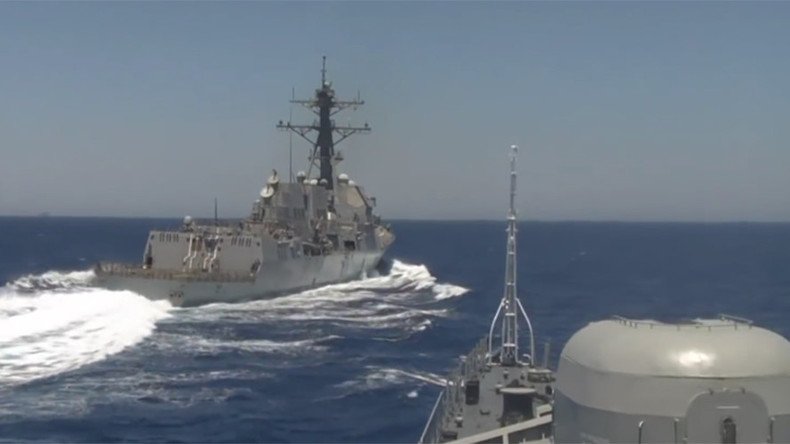Russian frigate ‘shadowed’ US carrier in recent encounter – Pentagon sources

The recent incident in which the USS Gravely made a close-in pass on the Russian frigate Yaroslav Mudry in the Mediterranean was a case of the US vessel trying to protect an aircraft carrier from Russian “observing operations,” the Pentagon claimed.
In the recent mid-sea encounter, the US guided-missile destroyer Gravely made a high-speed, close-in maneuver just meters away from the Russian Navy frigate Yaroslav Mudry. The encounter took place on June 17 in the eastern part of the Mediterranean.
The USS Gravely approached the Yaroslav Mudry and passed across her course at a “dangerous” distance of 180 meters (55ft), the Russian Defense Ministry said in a statement on Tuesday, adding the Americans’ conduct was profoundly unprofessional and violated a number of international maritime regulations.
But an anonymous American defense official told Defense News that there was more to the incident, insisting the Russian frigate was observing operations and maneuvered too close to the US carrier Harry S. Truman, which was being escorted by the USS Gravely.
“Gravely was operating astern of Harry S. Truman, and assessed that 777 [Yaroslav Mudry’s pennant number] was intentionally trying to interfere with Harry S. Truman operations,” a US defense official told the media.
The USS Gravely therefore moved to place herself between the Yaroslav Mudry and the USS Truman, but “the Russian closed to within 315 yards,” the official said – in contrast to the Russian Defense Ministry’s assertion that the Gravely passed across the Yaroslav Mudry’s course at a distance of 55ft.
US destroyer gets dangerously close to Russian patrol boat in Mediterranean – Moscow
The media cited the official as saying that the Russian frigate had displayed day shapes “ball-diamond-ball,” an international signal for a vessel restricted in her ability maneuver, but then freely maneuvered in both course and speed as the Gravely changed course and speed.
“The maneuvering demonstrates that 777 [Yaroslav Mudry] the was not in fact restricted in her ability to maneuver, and was thus intentionally displaying a false international signal,” the official said. He added the warships were closer to each other than in similar incidents involving the Russian and US navies.
The US Navy has recently deployed two Carrier Strike Groups (CSGs) in the Mediterranean, with the aircraft carriers Harry S. Truman and Dwight Eisenhower and their escort active in the operational area at the same time.
Life Aboard the USS Harry S. Truman | @andrea_shalal@Reutershttps://t.co/2lljTIuhUtpic.twitter.com/jKoiw2lb1X
— RealClearDefense (@RCDefense) June 22, 2016
“There are undoubtedly folks who are watching [the deployment] and this is just a graphic representation of what we’re capable of,” said US Rear Admiral Bret Batchelder, the highest-ranking officer on the USS Eisenhower, as cited by the Wall Street Journal in early July.
“It provides some needed presence in the Med to check … the Russians,” an unnamed military official told the magazine, explaining the presence of two carriers in the area. “The unpredictability of what we did with Truman kind of makes them think twice.”
The Harry S. Truman is a flagship of Carrier Strike Group 8 comprising the Ticonderoga-class guided-missile cruiser Anzio and several escort ships, including two Arleigh Burke-class destroyers, the Gravely and the USS Gonzalez.
Russia has maintained a naval task force of about 10 to 15 ships in the Mediterranean.













